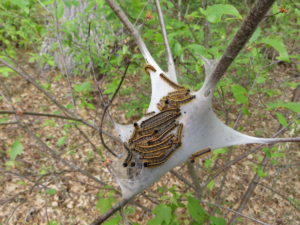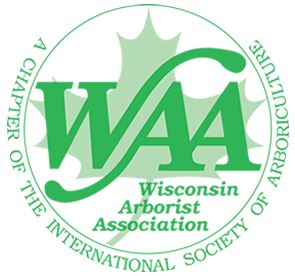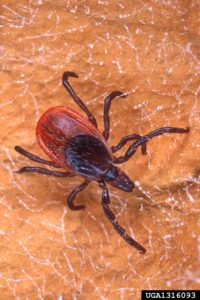Mike Hillstrom, forest health specialist, Fitchburg, Michael.Hillstrom@wisconsin.gov, 608-513-7690
Eastern tent caterpillars (ETC) are hatching and beginning to feed on host trees, including cherry, apple and crabapple. Landowners and homeowners may notice the white silken tents forming in branch forks. Although they form unsightly tents, ETC is a native insect so management is not typically necessary. Even completely defoliated trees will put out new leaves within a few weeks.

A group of eastern tent caterpillars warm themselves on white silk tent before leaving to feed on black cherry leaves.
If landowners want to remove the tents the best time to do so is early morning or evening when the caterpillars are inside. Unless it is raining, eastern tent caterpillars leave their tents each morning to feed throughout the day before returning at night. Caterpillars can be removed either by hand if they are within reach or with a rake if they are high in the tree. They can then be killed by soaking them in soapy water or sealing them in a trash bag. Insecticides are rarely necessary but should penetrate inside the tent if used. Do not prune branches, burn tents or soak them with WD-40. These methods are more harmful to the tree than ETC defoliation and are not recommended.
For more information on eastern tent caterpillar, read this factsheet from UW-Madison Division of Extension.
 Forestry officials suggest caution with fireworks
Forestry officials suggest caution with fireworks
 Join the WAA (Wisconsin Arborist Association) for their summer conference and picnic at the Green Lake Conference Center in Green Lake on Tuesday, July 16th. The program committee has put together another excellent lineup for this event. They are offering two educational tracks, one indoors and one outdoors- a little something for everyone.
Join the WAA (Wisconsin Arborist Association) for their summer conference and picnic at the Green Lake Conference Center in Green Lake on Tuesday, July 16th. The program committee has put together another excellent lineup for this event. They are offering two educational tracks, one indoors and one outdoors- a little something for everyone.


